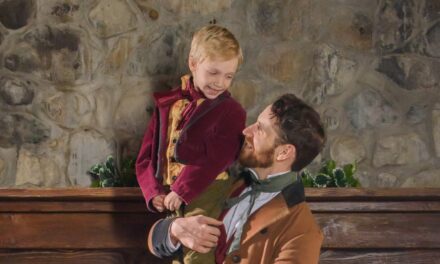OGDEN — In the song “Finishing the Hat,” from Sunday in the Park with George, the artist George Seurat makes a case for his dedication to art for art’s sake. He laments, but also accepts, the price he pays in his personal life for living in “the world of the hat,” for the privilege of creating things that weren’t there before. Weber State’s decision to produce this Stephen Sondheim (music) and James Lapine (book and lyrics) musical, so seldom seen in Utah and never before reviewed by UTBA, makes a similar statement. The considerable merits of director Andrew Barratt Lewis’s production notwithstanding, selling tickets to Sunday in the Park was always going to be an uphill battle, and the joy of “putting it together” must be its own reward. As far as I’m concerned, it was worth it.

Show closes April 13, 2019.
The first act presents Lapine and Sondheim’s imagined version of George (played by Christian Johnston) while he works on his famous painting, A Sunday Afternoon on the Island of La Grande Jatte, completed in 1886. The story includes the artist’s relationship with Dot (Morgan Hekking), who models for him, and glimpses of the lives of the other people in the painting as he sketches them in the park. The second act picks up in America, where George and Dot’s daughter, Marie (also played by Hekking), participates in the exhibition of Chromolume #7, a light sculpture by her grandson, George (also played by Johnston). Throughout the play, both Georges’ works serve as a catalyst for observations on the nature of art, beauty, and change.
Sunday in the Park with George, winner of the 1985 Pulitzer Prize for Drama, and Sondheim’s first collaboration with Lapine (with whom he would also write Into the Woods and Passion), is an innovative achievement that at times represents peak Sondheim and at others peak Sondheim-ness. The space between those can be infinitesimal, but also infinitely deep. To understand this, one need look no further than Seurat’s signature technique in painting A Sunday Afternoon, pointillism, which is a metaphor for much of the show
Pointillism consists of painting in small brushstrokes (such as dots) with a limited number of pigments, allowing the colors to be mixed by the eye of the observer. Sunday in the Park reproduces this phenomenon when Sondheim’s and Lapine’s talents combine before the audience, as if for the first time, in an experience that communicates the transformative power of art both in aesthetics and content. Yet occasionally one feels too close to the brushstrokes and the illusion collapses, drawing attention instead to the authors’ idiosyncrasies. While this phenomenon is interesting in its own right, it skates dangerously close to self-parody, and the aggregate can feel uneven. The constant oscillation between synergy and the sum of the play’s parts contributes, perhaps, to its genius, but it is also what gives it a deservedly challenging reputation.
DJ Pike’s set (small canvases stage right, large canvas stage left), Lapine’s book (vignettes that later come together as a whole), and the texture of Sondheim’s score all suggest this same process at some level. It works wonderfully in the first act, when the considerations about art are balanced with the minor character episodes and Dot’s relationship with George. In the second act, however, the relationship between the very elderly Marie and her grandson can’t sustain the same tension, perhaps because their interactions aren’t as fraught or perceived as at odds with the artistic impulse.
Moreover, while the first act features a real (if fictionalized) painter with a historical work of art at its core, the second act has no such anchor. Even in the most elaborate productions of this show, the asymmetry in impact between A Sunday Afternoon on the Island of La Grande Jatte and Chromolume #7 can easily induce a cringe or make the latter trip over the line into satire. I’ve definitely seen better realizations of Chromolume than Weber’s, but I hesitate to be harsh because I’m also not sure I have any solutions to offer. Still, for better and worse, how seriously one is able to take Chromolume colors one’s reaction to the script’s commentary on commercialization and self-absorption in the art industry.
Navigating the myriad tightropes that Sunday in the Park presents is a tall order even for performers and artists at the pinnacle of their fields, so Weber’s entire cast and technical team deserve much praise for what they have accomplished. The whole production is a showcase of the tremendous breadth and depth of Weber’s program, from Catherine Zublin’s costumes to Korey Lamb’s sound design that cradles the singing so deftly within the orchestra (and kudos to Cole Sorensen for nailing some very exposed horn solos).
Hekking is nothing less than extraordinary as Dot, transcending the character’s one-dimensional name with a multi-faceted performance. It shimmers with a dynamic stage presence, unexpected line readings, vivid subtext, and a seemingly effortless control of her singing voice. Her rendition of “Sunday in the Park with George” is easily the best opening number I have seen in a long time. Johnston’s taciturn George provides a satisfying counterpoint. I am not convinced he shows off his voice’s full potential in “Finishing the Hat,” but I was captivated by the few, brief instances when George and Dot touch, as at the end of “Color and Light.” These glimpses of George when he crosses over “from this world to that” and fully directs his gaze at Dot give these moments an understated, elegant lyricism. I also admired the interactions between George and his mother (Karen Bruestle), particularly their duet, “Beautiful,” as well as so many other small details from the ensemble vignettes in which there is not a weak link to be found.
Unfortunately, Sunday in the Park’s run was confined to one weekend, which precludes me from encouraging anyone else to go see it. But, for whatever it’s worth, I am pleased to express my admiration for what Lewis and everyone else have created. As George and his mother suggest in “Beautiful,” I’ll write it down before it fades, but the fact that it has disappeared is part of what contributes to its beauty.





